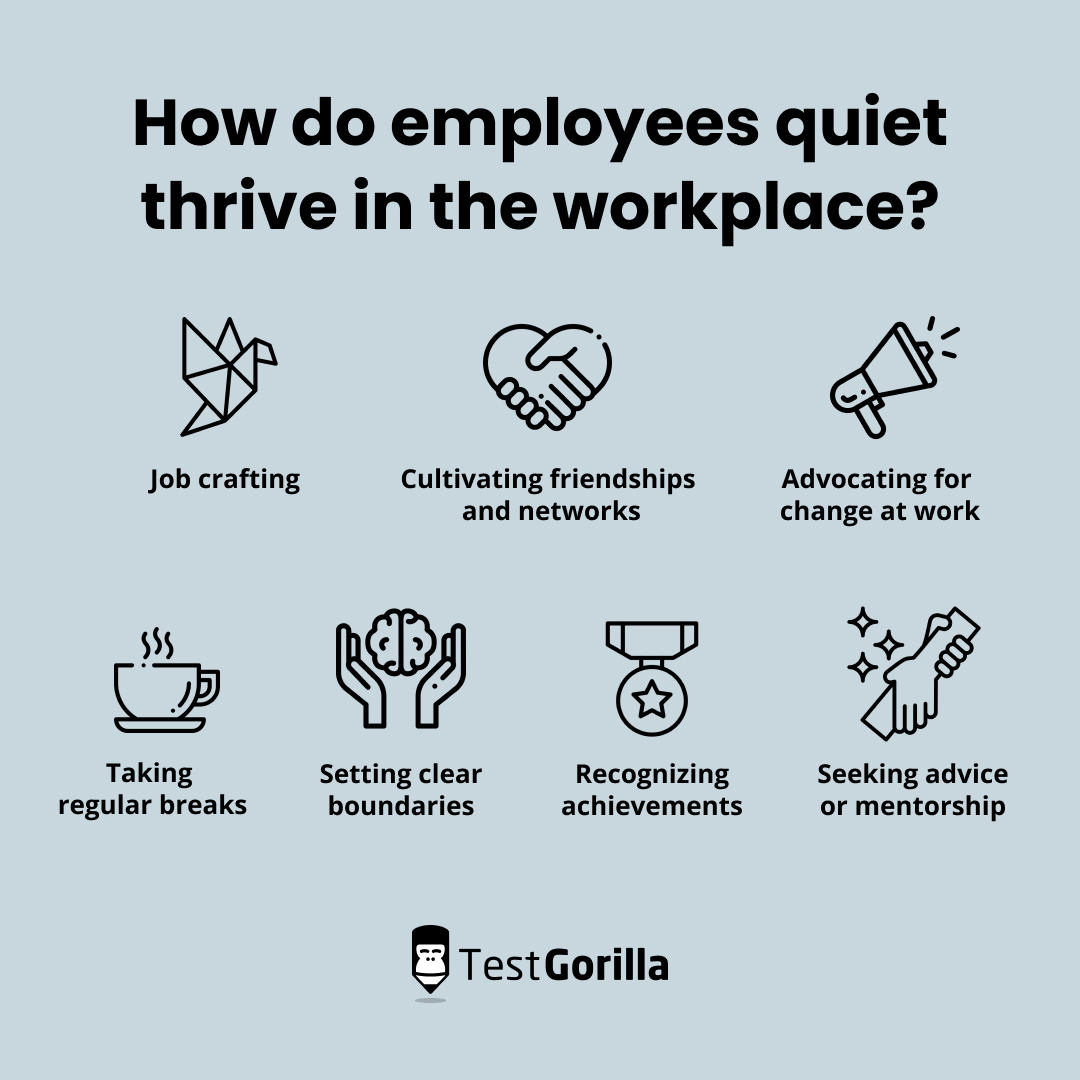We’ve all heard of quiet quitting, but it’s often not a great idea.
Brooks E. Scott, a career coach, points out that workers from minority and underrepresented groups are more likely to face repercussions if they try to quiet quit.[1]
And across all demographics, giving up ownership of your role can be disempowering. It prevents workers from advancing their careers and limits their ability to pursue new opportunities.
Enter “quiet thriving,” a new workplace trend all about finding ways for employees to re-engage with their jobs.
But what does quietly thriving look like in practice, and how can you make sure it happens in your workplace?
Read on to learn how you can build, engage, and support quiet thrivers in your company, from pre-employment testing to the end of the employee life cycle.
What is quiet thriving?
Quiet thriving happens when employees actively make changes to their work life so they feel happier and more fulfilled.
This increase in fulfillment leads to more engaged employees who are more invested in their work. That’s great for employers; research shows the most engaged and least engaged employees yield different business outcomes.
More engaged employees were:
81% less likely to engage in employee absenteeism
64% less likely to experience safety incidents or accidents
43% less likely to generate employee turnover in low-turnover organizations
23% more likely to do profitable work[2]
The term is derived from the other famous “quiet” workplace behavior: quiet quitting. Psychotherapist Lesley Alderman coined “quiet thriving” in the Washington Post, exploring how employees can re-engage with their work.
Quiet thriving vs. the other “quiets”
Quiet thriving is the beginning. There are several ways things happen “quietly” in a workplace. Here are the other “quiet” workplace phenomena you may have heard of:
Quiet behavior | What it means |
Quiet quitting | Employees disengaging from their work and doing the bare minimum, often as a way to cope with burnout |
Managers trying to get rid of employees without firing them outright, usually by withholding opportunities, support, or resources from the targeted employee | |
Companies shifting new responsibilities onto current employees instead of hiring new workers to meet business needs |
Beyond the “quiet” part – a subtle behavior unlikely to be enshrined in policy – thriving doesn’t have much in common with quiet firing or quiet hiring. In fact, employees might choose to quietly thrive in response to quiet hiring or firing from managers.
The upheaval of being quietly hired or fired could prompt a worker to re-evaluate how they approach their working day, and seek out ways to adapt to the new pressures placed on them.
Of course, they might decide to try quiet quitting instead. Both quiet quitting and quiet thriving are decisions employees take on their own without input from their employers.
But unlike quiet quitting – a hallmark of the Great Discontent – quiet thriving is a positive decision that empowers employees to approach their work differently instead of giving up on it.
And with quiet quitters making up roughly 50% of the US workforce, employers stand to gain a lot from encouraging quiet thriving. It empowers employees to adapt to difficult circumstances and deliver better work.
How do employees quiet thrive in the workplace?
If you want to support your quiet thriver employees, you need to understand what quiet thriving looks like in practice. Here are some common steps workers take when deciding to thrive quietly at work.
Job crafting
Job crafting is the practice of adjusting your own responsibilities at work to make your job more satisfying or appealing.[3] An employee might ask their manager if they can spend more time on the tasks that feel most meaningful, or even take on new duties they might enjoy.
Cultivating friendships and networks
In a survey, 57% of workers said they find work more enjoyable thanks to a workplace friendship.[4]
And for employees who feel isolated at work, finding a group of like-minded colleagues may help them engage. The group could be an informal network of friends or a more organized employee resource group.
Advocating for change at work
Workers might find it hard to make the changes they need to thrive quietly. In that case, they may advocate for themselves in a collaborative way with their managers.
The goal is to implement the changes they want, which could range from more team-building opportunities to more flexible work patterns. This is a sign of engagement, and it can even help managers pay closer attention to employee voice.
Taking regular breaks
Research shows short breaks from work tasks improve employees’ focus and efficiency.[5]
Employees who take regular breaks deliver quality work while managing their risk of mental health problems like stress and burnout.
Setting clear boundaries
Employees set boundaries, such as turning off work phones at the end of the day, to protect themselves from burnout and overwork. Without boundaries, they may end up taking on work that goes beyond their job description, which prevents them from thriving.
Recognizing achievements
It’s easy for workers to lose sight of their successes if they don’t take the time to celebrate them. Employees committed to quietly thriving might make regular lists of their achievements at work, a way to stay focused on their own abilities and make positivity a consistent habit.
Seeking advice or mentorship
Finally, employees who are looking for ways to thrive might pursue opportunities for mentorship, coaching, or other forms of professional development. A mentor or coach provides valuable advice that informs employees’ choices at work.
Why are employees deciding to thrive quietly?
Thriving quietly is the other side of the coin of quiet quitting. But until now, we’ve mainly heard about quiet quitters in the workplace. Where did the concept of quiet thriving come from, and why is it becoming popular with workers?
We know employees’ decision to quietly quit is bad news for their employers. The truth is that, in the long term, quiet quitting isn’t great for employees either.
According to the Sloan Management Review, employees who become quiet quitters may be hurting their own professional development. Quiet quitting can:
Prevent the employee from developing resilience
Lead others to believe the employee is unmotivated or unqualified
Generate negative feedback from clients
Result in poor references when the employee tries to find a new job
All of those negatives add up, and as the job market starts to cool down, employees are increasingly aware of the lasting reputational damage of quiet quitting and disengagement.
So what are their other options?
They can quit outright, which feeds into a catastrophic cycle of churn and burn for employers, or they can change their mindset and find ways to make their work life more sustainable.
By finding a healthier, more stable work-life balance, employees unlock new levels of resilience and are more able to deal with adversity at work. They aren’t only healthier; they’re better equipped to take on new challenges with a positive outlook.
That’s quiet thriving, and it isn’t good for only employees. As we’ve already explained, quiet thriving boosts retention, limits absenteeism, and fosters a much healthier culture within your company. That’s why it’s crucial for HR and recruiting professionals to take quiet thriving seriously.
Read on to learn what you can do to promote quiet thriving at work.
We’ll cover tips for HR professionals in the next section, with advice for recruiters in the section after.
The best insights on HR and recruitment, delivered to your inbox.
Biweekly updates. No spam. Unsubscribe any time.
How can HR professionals support employees who are quiet thriving?
As an HR professional, it’s important to support quiet thrivers in practical, meaningful ways.
Here are nine top tips to guide your approach to building a culture of quiet thriving within your company.
Supporting quiet thrivers at a glance
What you can do | How it helps |
Use talent assessments to hire the right people | Builds a supportive culture in which all your employees are empowered to contribute |
Support employees in crafting their own jobs | Gives workers room to take initiative and engage directly with the structure of their roles |
Invest in training and promote internal mobility | Keeps staff from feeling trapped or stagnant in their roles, offering them space to grow |
Enable staff to set healthy boundaries | Limits the risk of burnout and protects employee health and wellbeing |
Offer flexibility at work | Gives staff greater freedom to adjust their work days to suit their needs |
Provide wellness initiatives | Supports workers in maintaining their wellbeing |
Build an open, respectful, and inclusive culture | Creates an environment that celebrates difference, including different ways of working |
Run team-building activities and events | Fosters a sense of team cohesion and community |
Celebrate employee achievements | Helps employees feel appreciated and respected, bolstering morale and engagement |
Use talent assessments to hire the right people
Quiet thriving is a cultural phenomenon. To build the kind of culture that supports quiet thriving, you need to hire people who will add to the culture you want.
This means considering all of the following factors when hiring:
Hard skills
Soft skills
Candidate personality
Culture add (as opposed to culture fit)
A skills-based hiring approach enables you to assess all these factors without the uncertainty of resume-based recruitment. It also makes it easier to avoid unconscious bias, so you can be sure you’re hiring the best people for the job.
Use skills testing and talent assessments to build a culture where everyone belongs – and feels more able to thrive as a result.
Support employees in crafting their own jobs
We’ve already mentioned job crafting, which is a popular approach for employees who are trying to thrive quietly. But job crafting is easier for workers when they have support from their managers – and that’s where you come in.
Talk to your staff about what they want to do, and be prepared to compromise to find ways for their goals to meet your business’s needs.
More generally, consider adopting a flexible approach to your workers’ career progression. Don’t railroad your employees into a linear path at the expense of their job satisfaction and wellbeing.
Instead, consider adopting a career portfolio approach that empowers your staff to pursue the work that truly engages them.
Recommended reading: How job crafting benefits your organization and employees
Invest in training and promote internal mobility
Employees want opportunities to develop professionally: 68% of surveyed workers consider employer-provided upskilling to be a crucial factor in deciding whether to take a job.[6]
Training opportunities at work help employees feel more engaged with their roles. That’s the foundation of a culture of quiet thriving.
Once you have training schemes in place, give your employees room to put their new skills to use through an internal mobility program. Giving your staff scope to advance within your organization keeps their loyalty high and encourages them to invest in their work.
Don’t forget to promote internal opportunities so your staff can set goals and plan their careers more easily.
Enable staff to set healthy boundaries
Employees who don’t feel able to set boundaries around their work are much more likely to become quiet quitters. Building a culture of boundary-setting in your company is a simple, effective way to promote and support quiet thriving.
If you aren’t sure how to support your workers’ boundaries, consider taking these steps:
Talk openly about boundaries with your workers as early as possible
Establish clear roles and responsibilities for all your staff
Use tech tools to empower your employees to delegate and share work
Write a policy that discourages out-of-hours work emails or calls
Above all, listen to your employees’ voices. They understand what they need to optimize their experience at work.
Offer flexibility at work
A core principle of quiet thriving is that employees should have the ability to adjust their day-to-day work in small ways to suit their needs.
They need flexibility in their jobs. That could mean a policy that allows staff to work from anywhere, or adjustable work patterns so they can set their own work hours and take a break when they need to.
A 2022 survey by McKinsey shows that when offered the opportunity to work flexibly, 87% of Americans do so. That’s because workers are increasingly valuing autonomy – another reason why quiet thriving is a trend on the rise.
If you can’t offer as much flexibility as your employees want, consider other ways to provide a healthy work-life balance instead.
Provide wellness initiatives
According to research by Forbes, mental health assistance is the fifth most popular benefit: 33% of employees called it highly desirable, compared to 23% of employers.
Set yourself apart in the search for top talent by offering wellness initiatives to your staff. Here are just a few nontraditional benefits to support your employees’ mental state:
Physical wellness and nutrition programs (You might even decide to hire a dietitian or a gym instructor)
Financial planning and advice
Mental health days
There’s one more crucial wellness initiative you can implement for free: a culture that supports frequent breaks. As we’ve explained, quiet thrivers understand regular work breaks are great for productivity and mental wellbeing.
Make sure your business supports them, instead of shaming them for stepping back when they need to.
Build an open, respectful, and inclusive culture
Companies with a positive and inclusive culture are companies where employees feel welcome and respected. This boosts morale and engagement, and ensures workers feel comfortable working in the ways that suit them best.
That’s because the best company cultures are inclusive of all types of difference – even different ways of working. A truly inclusive culture acknowledges that no two people think or work the same way, and it celebrates workers for working in ways that suit them best.
That could mean building a culture of neurodiversity or just a culture of mutual respect and support, motivating all your employees to excel.
Run team-building activities and events
Employees thrive when they’re able to build friendships and networks at work. As an HR leader, you are in the perfect position to encourage team-building within your company.
Organize and run team-building events and activities to give your workers the best chance to get to know each other. Consider activities like:
Regular team coffee breaks or lunches
Scavenger hunts
Escape rooms
Team retreats
Team-building exercises are especially important for remote or hybrid work environments, where physical distance makes it hard to develop a cohesive culture without intentional work.
With that in mind, make sure the activities you run are remote-inclusive. After all, you aren’t building a real community unless all members can participate.
Celebrate employee achievements
When surveyed, 69% of employees said they would work harder if they felt their effort was recognized properly.[7] Celebrating yourself is great, but it means a lot to get recognition from the people you work with, too.
Build up your workers by celebrating their achievements. Whether it comes in the form of peer to peer recognition or acknowledgment in a 1:1 meeting with a manager, give your employees regular positive feedback to keep them motivated and engaged.
You can also make positive feedback a more public affair by announcing great performance by individual staff members in internal newsletters or team meetings.
How can recruiters attract employees wanting to thrive quietly?
Roughly two-thirds of all candidates are passive candidates, workers who may be in “quiet quitting” mode but aren’t actively looking for a new role.
As a recruiter, you can reach these passive candidates by showing them you want to help them thrive quietly.
That means positioning your company as one that supports quiet thriving in all its forms. Here are the steps you can take to make that happen and to reach a wider audience of employees who want to engage with their work.
Recruiting quiet thrivers at a glance
What you can do | How it helps |
Speak up about your company culture | Signals to candidates that your company values them and their wellbeing |
Display your company policies online | Gives applicants a clear picture of how your business supports quiet thrivers |
Seek testimonials from existing employees | Offers first-hand insight into the culture your company has built |
Be respectful and accommodating during the recruitment process | Shows applicants how they will be treated as a member of your team |
Promote your business’s skills-based approach to hiring | Shows candidates that they will be celebrated for their abilities and skills |
Speak up about your company culture
If you’ve worked to build a culture that supports quiet thrivers, that’s your biggest selling point as a recruiter. Candidates stuck in quiet quitting mode are looking for something better, and it’s up to you to be loud and proud about what you have to offer these applicants.
Let people know what’s great about your company culture by:
Living your business’s values and building a reputation for it
Using social media like LinkedIn to share ideas about company culture
Promoting your culture – and what you’ve done to build it – on your website
A toxic culture is a huge reason why employees leave jobs. Use your positive, welcoming culture to invite people in instead.
Display your company policies online
Remember, it’s one thing to say your business is welcoming to quiet thrivers. But candidates – especially those who have had bad experiences with previous employers – may be suspicious if you can’t back it up.
By making your company policies accessible on your website, you show that you’re ready to back up your principles in practice. It means candidates can see exactly what your business does to encourage and support quiet thriving.
Make sure your policies are clearly signposted so curious candidates can find them easily. Don’t bury them; be proud of your company and its policies!
Seek testimonials from existing employees
If you have a great company culture, your current employees should be your best salespeople. They have direct experience of your culture and policies, so they’re well-placed to talk about how welcome and supported they feel working for you.
That’s an invaluable recruiting tool. As a recruiter, it’s worth your time to promote your company through employee testimonials.
Consider making room for employee profiles and stories on your company website or publishing quotes from employee testimonials on social media. Candidates will respond to your current staff’s positive experiences and get a clearer idea of what to expect from you.
Be respectful and accommodating during the recruitment process
Quiet thriving should be for everyone. But if you aren’t prepared to make reasonable accommodations for candidates who need them, you’re telling those candidates that they aren’t welcome in your business.
Make it easy for candidates to tell you what they need when they attend interviews or prepare for talent assessments. This shows them how they can expect to be treated as a member of your team: with respect, fairness, and consideration.
You should also respect candidates’ preferred pronouns and forms of address from the beginning of the hiring process. It may seem like a small thing, but it’s a powerful signal of respect and welcome to transgender applicants.
Promote your business’s skills-based approach to hiring
Candidates love skills-based hiring. In our State of Skills-Based Hiring report, we found:
54.3% of candidates prefer a skills-based hiring process
72.1% of people recruited via skills-based hiring are happy in their role
Employees hired through skills-based hiring have a 50% lower rate of attrition
Plus, we’ve already explored how skills-based hiring helps businesses build a culture that supports quiet thriving. It’s a great move for everyone, and it makes your workplace attractive to top talent.
So don’t keep it quiet – speak up about skills-based hiring. Promoting your hiring methods lets quiet thrivers know that your company has their interests at heart.
Foster a culture of quiet thriving at work
Employees who quiet quit don’t make an effective contribution to your business. But workers who are quiet thriving are more engaged, more productive, and more successful.
All it takes to transform a quiet quitter into a quiet thriver is a shift in mindset. To facilitate that shift, you need to transform your culture so that all your staff feel supported and empowered in their roles.
That way, everyone in your business has the opportunity to thrive – quietly or otherwise.
Next, learn more about transforming your culture to build a thriving workplace in our seven-step guide to cultural change.
And start making change from the ground up with our Culture Add test, a crucial tool for hiring workers who contribute meaningfully to your culture.
Sources
Bhaimiya, Sawdah. (July 9, 2023). “Stop quiet quitting and start 'quiet thriving' to build resilience and help find joy in your job, experts say”. Business Insider. Retrieved July 10, 2023. https://www.businessinsider.com/quiet-thriving-empowering-career-strategy-joy-work-quiet-quitting-2023-5
“The Benefits of Employee Engagement”. (June 20, 2013). Gallup. Retrieved July 10, 2023. https://www.gallup.com/workplace/236927/employee-engagement-drives-growth.aspx
Berg, Justin; Dutton, Jane; Wrzesniewski, Amy. (January 2008). “What is Job Crafting and Why Does It Matter?”. ResearchGate. Retrieved July 10, 2023. https://www.researchgate.net/publication/266094577_What_is_Job_Crafting_and_Why_Does_It_Matter
Stevens, Paris. (July 19, 2021). “The 2021 Workplace Friendship & Happiness Survey”. Wildgoose. Retrieved July 10, 2023. https://wearewildgoose.com/usa/news/workplace-friendship-and-happiness-survey/
“Brief diversions vastly improve focus, researchers find”. (February 8, 2011). Science Daily. Retrieved July 10, 2023. https://www.sciencedaily.com/releases/2011/02/110208131529.htm
“The American Upskilling Study: Empowering Workers for the Jobs of Tomorrow”. (n.d.) Gallup. Retrieved July 10, 2023. https://www.gallup.com/analytics/354374/the-american-upskilling-study.aspx
Kolowich Cox, Lindsay. (July 6, 2015). “11 Eye-Opening Statistics on the Importance of Employee Feedback”. HubSpot. Retrieved July 10, 2023. https://blog.hubspot.com/marketing/11-employee-feedback-statistics
You've scrolled this far
Why not try TestGorilla for free, and see what happens when you put skills first.




















